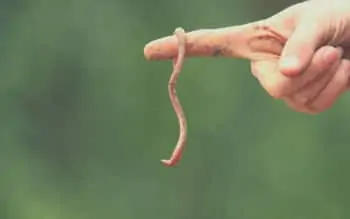At first, the sight of worms in your potted plants might annoy you, urging you to cast them off immediately. But when you look into the matter a bit deeper, you would probably want to reconsider your decision.
Are you worried because you’ve found worms in your indoor plants? Or your curiosity about the science behind worms and their relation with plants is what brought you here?
Normally there aren’t any worms in house plants, they are usually in your outdoor plants. Most worms are not harmful to your plants and are normally beneficial because of their castings. but there are some to watch out for like cutworms. I would not recommend putting them in your indoor plants.
Table of Contents
Are Worms Good or Bad for Plants?

Worms are usually more frequent in outdoor plants than indoor potted plants. That’s because outdoor soil offers favorable conditions vital for their growth; worms need damp, moist, and alluvial soil to survive.
If you see worms in your indoor plants, don’t worry, they are not bad for your plants. Instead, they are beneficial and can aid plants in their growth. They can aerate plants, decompose bacteria, and provide nutrition to plants.
However, many times you may find that a plants’ health is declining due to worms, but the reason might be something else.
Even though worms enrich the soil with their excretions, they still might hinder plant growth. In potted plants, there is not an abundant supply of biomass and organic matter. When there is no more matter left for the worm to consume, they start eating the plant’s roots, which can hinder its growth or even kill it.
Will Worms Eat My Plants.
Will worms eat my plants? The answer is no, the worms mostly eat dirt, animal, and organic matter things like the leaves, the dead roots, and grass. They digest what they eat and turn it into fertilizer which can then be used by the plants to help them grow
Worms That Help and Hinder Indoor Potted Plants – Understanding the Types

It is possible to achieve desired results through worms if you use the suitable types in the right quantities. They can provide nutrients to the soil, but you still need to be cautious. Adding too many worms will only cause a decline in plant health
Worms come in different sizes and shapes. If you want to maximize plant growth, you must be aware of varying worm types and their impact on plant health.
Beneficial Worms: A Treat for your Plants
Pot Worms, Red Wigglers, and Night Crawlers can be effective if used in the right amount.
1. Pot Worms
Did you even know that there are worms called “pot worms”? Yes, they do exist!
As the name suggests, these worms are exclusively ideal for indoor potted plants.
These are tiny worms that aerate topsoil, and they also protect against harmful bacteria and fungi by consuming them. Even if they are present in thousands, they will not harm plants.
2. Red Wigglers
Red Wigglers are 2-3 inches long worms that are red-brown and are called “composting worms.”
They decompose organic matter and turn them into valuable nutrients for the soil to maintain the plant’s health. They are consuming dead or dying leaves and roots, and their castings are all filled with essential nutrition.
3. Night Crawlers
Nightcrawlers are the most common type of brownish-grey worms and can grow up to 3-14 inches. They are known as nightcrawlers as they constantly crawl from topsoil to subsoil.
- Their movements aerate the soil.
- They make way for oxygen to reach soil and plant roots.
- They decompose bacteria and fungi.
- They leave castings as they move from the top layer to subsoil.
Harmful Worms: Keep Them Away
The worms mentioned below are harmful and can hinder plant growth.
1. Millipedes
Millipedes are 1 inch round and brown worms that can eat plant leaves and roots. If they are in indoor plants, they may cause more harm to you than the plant itself. That’s because they excrete a fluid that can cause allergic reactions to human skin.
2. Cut Worms
Cutworms are caterpillars that are larvae stages of butterflies, beetles, or moths.
They are destructive for plants as they eat healthy stems, roots, and leaves.
You can get rid of them by pouring soapy water into the pot, which will make them appear on the surface. You can then manually pick them up one by one. If unavoidable, pesticides can also handle the issue.
Like millipedes and cutworms, grub worms and nematodes are also harmful to indoor plants, so try to rid them in time for proper plant growth.
Our Summary
Worms are usually present in every household plant pot, but the only particular kinds of worms can improve plant growth and stimulate optimal health. However, there are some worms that can have adverse effects, and hinder growth.
Knowledge about worms and their types will not only make you understand them better but assist you in deciding what’s better for your indoor potted plants.
Nature is always there to help you out if only you know how to handle it. It can help and guide you in promoting your plant’s health, all you need to do is let it happen the right way!
Recent Posts
Have you found yourself wondering, 'why is my bamboo growing so slow?' Despite the fact that bamboo plants are remarkably fast-growing, it can sometimes take months (or even years!) to see any signs...
Miracle-Gro is a huge help when you are trying to get decent yields out of your plants or if you want them to thrive. However, you may have noticed that a single dose of fertilizer does little to...
